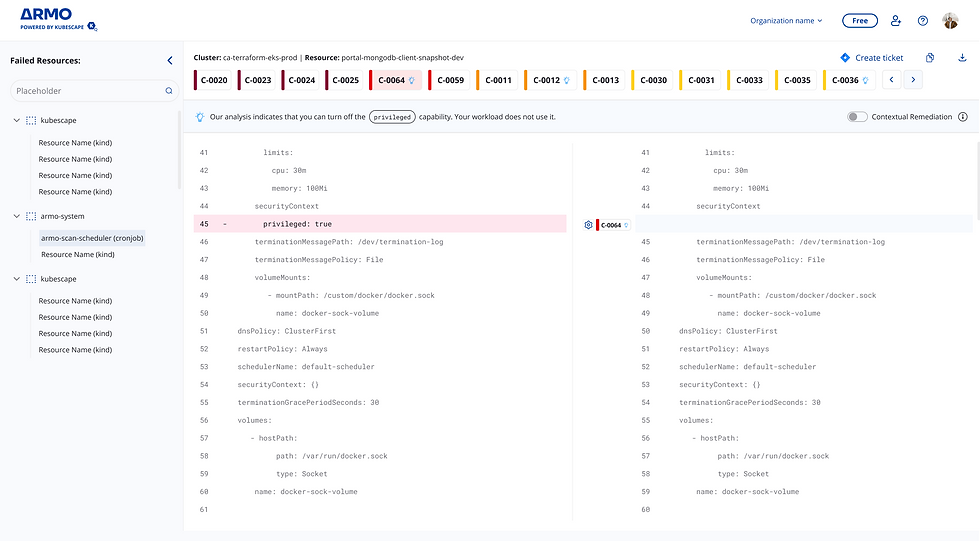Side-by-Side Remediation:
Enhancing Threat Response Efficiency
In the fast-paced world of DevOps, managing and fixing misconfigurations is a critical aspect of maintaining operational excellence. This case study explores the design and implementation of ARMO's Side-by-Side Remediation Feature. Tailored specifically for DevOps professionals, ARMO Platform enhances their ability to identify and address misconfigurations swiftly.
The Impact
-
Time spent on remediation → Reduced by 60%, as analysts no longer needed to manually cross-reference data.
-
User adoption → Increased engagement from security teams due to improved efficiency.
-
Error reduction → Analysts reported fewer misinterpretations of security policies.
Company:
Platform:
Kubernetes Security Dashboard (Web platform)
Role:
Product Designer
Duration:
3 months (Q1 2024)
Team:
Product Manager
Frontend Developer
2 Backend Developers Security Researcher
Product Designer (me)

Assisted SBS Remediation

Assisted SBS Remediation
The Challenges & Goals
The Challenge
Before this feature, security analysts had to:
-
Manually switch between multiple screens to compare misconfigurations.
-
Rely on complex documentation to understand expected security policies.
-
Risk misinterpretation due to the lack of a structured, side-by-side comparison.
The Goal
Our objective was to build a new remediation workflow that:
-
Allowed direct, side-by-side comparison of misconfigurations and their resolutions.
-
Provided contextual recommendations to guide analysts in fixing security issues.
-
Enabled quick remediation actions to reduce time spent on security fixes.
-
Integrated seamlessly into existing security processes without disrupting workflows.
✅ TL;DR The Problem:
Security analysts were slowed down by having to manually switch between scattered screens and complex documentation to compare and resolve cloud misconfigurations, increasing the risk of human error.
Research & Requirements Gathering
To inform our design, I conducted:
-
User Interviews → Spoke with security analysts to document pain points and workflow inefficiencies.
-
Competitive Analysis → Evaluated how other platforms handle security misconfigurations.
-
Usability Studies → Tested initial concepts with security professionals to refine functionality.
Key Findings:
-
Reducing friction was essential—analysts wanted fewer clicks and easier navigation.
-
Visual clarity was critical—clear highlights and contrast helped users spot differences quickly.
-
Automation was highly valued—pre-populated recommendations saved time and reduced human error.
Stakeholder Alignment & Collaboration
-
Worked closely with security teams to ensure the feature met real-world investigation needs.
-
Partnered with engineers to define the best approach for integrating live security data.
-
Presented prototypes to leadership to secure buy-in and align business objectives.
Working Process
Defining & Refining Requirements
-
Mapped out the remediation workflow with security teams to identify key interaction points.
-
Defined technical constraints with engineers to ensure real-time data processing feasibility.
-
Prioritized features that maximized efficiency without compromising security accuracy.
Wireframing & Prototyping
-
Explored multiple dual-pane layouts to optimize for quick comparison and decision-making.
-
Created interactive prototypes to test how analysts interact with live remediation data.
-
Iterated on designs based on usability test findings, refining navigation and workflows.
Iterative Design & Refinement
-
Adjusted layout elements to enhance readability and usability.
-
Implemented progressive disclosure to reduce cognitive overload.
-
Added quick-action buttons for instant misconfiguration fixes.
-
Improved navigation by making security recommendations more discoverable.
✅ TL;DR Working Process:
Conducted user interviews, partnered with security teams and engineers, and iterated on prototypes to reduce cognitive load and streamline decisions.
User Flow

User Flow

User Flow
Design Process
The Side-by-Side Remediation design introduced a dual-panel layout that allowed analysts to investigate threats and take action within a single view. This was a completely new experience tailored to security workflows. Key innovations included:
-
Dual-Pane Interface → Analysts can simultaneously view misconfigurations and remediation steps, eliminating the need to switch screens.
-
Contextual Recommendations → Automated suggestions based on threat intelligence to assist in decision-making and guidance on the best remediation actions.
-
Quick Action Buttons → One-click options allow analysts to resolve issues instantly.
-
Live Updates → Changes sync across teams in real time, ensuring consistency.
-
Customizable Layout → Users can adjust panel sizes to focus on the most relevant data.
✅ TL;DR The Design:
Delivered a dual-pane UI with contextual recommendations, quick-action buttons, and live sync, reducing remediation time by 60%.

Assisted Remediation - Fix the control safely

Assisted Remediation - Fix the control safely

Assisted Remediation - Fix the control safely - Tooltip

Assisted Remediation - Fix the control safely - Tooltip

Assisted Remediation - Smart Remediation

Assisted Remediation - Smart Remediation

Assisted Remediation - RBAC

Assisted Remediation - RBAC
Success Criteria
To measure the impact of this new feature, we tracked:
-
Time spent on remediation → Reduced by 60%, as analysts no longer needed to manually cross-reference data.
-
User adoption → Increased engagement from security teams due to improved efficiency.
-
Error reduction → Analysts reported fewer misinterpretations of security policies.
Summary
By introducing Side-by-Side Remediation, we empowered security analysts with an intuitive tool to quickly identify and resolve misconfigurations—ultimately improving cloud security posture and reducing response time.
This project reinforced the importance of:
-
Stakeholder collaboration – Ensuring alignment across security, engineering, and leadership.
-
Iterative testing – Continuously refining the design based on real-world analyst feedback.
-
Cognitive load management – Designing a UI that simplifies complex decision-making.
-
Seamless integration – Creating a feature that fits naturally within existing security workflows.

